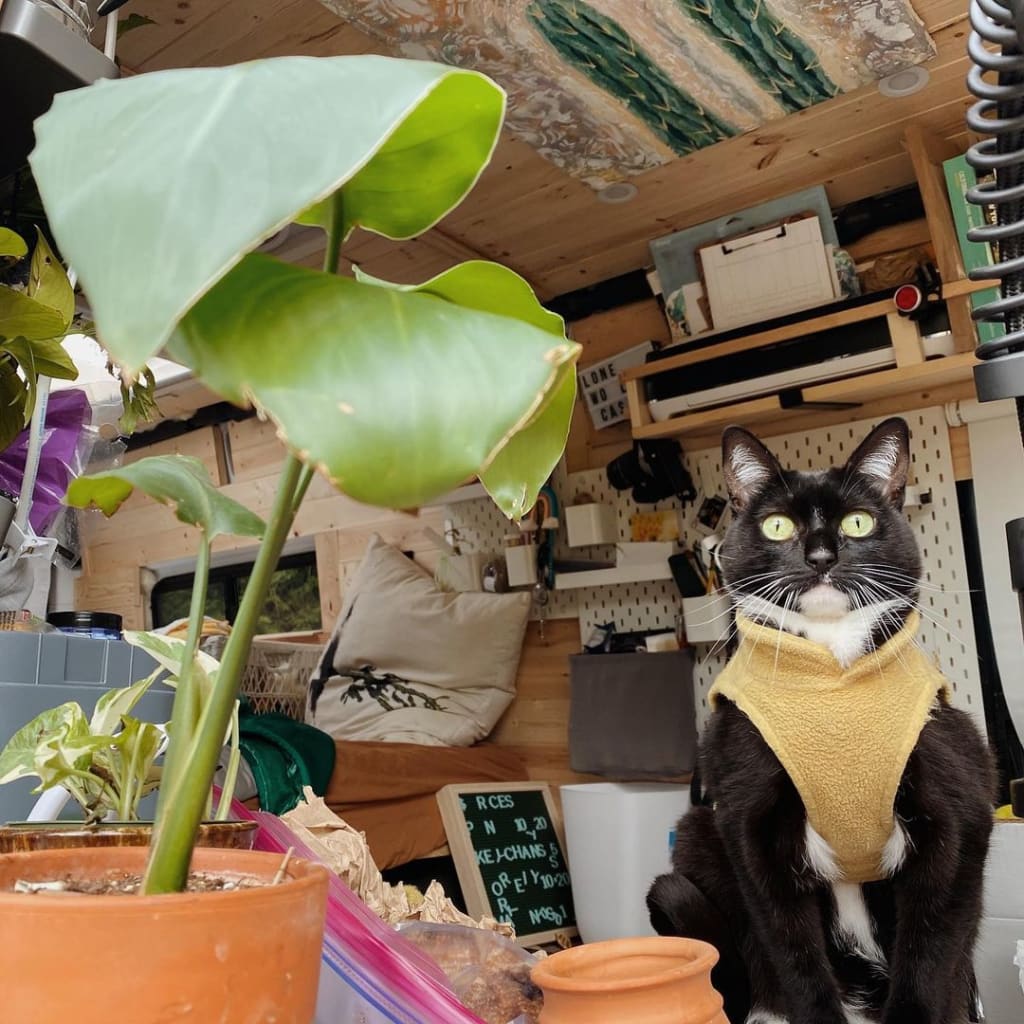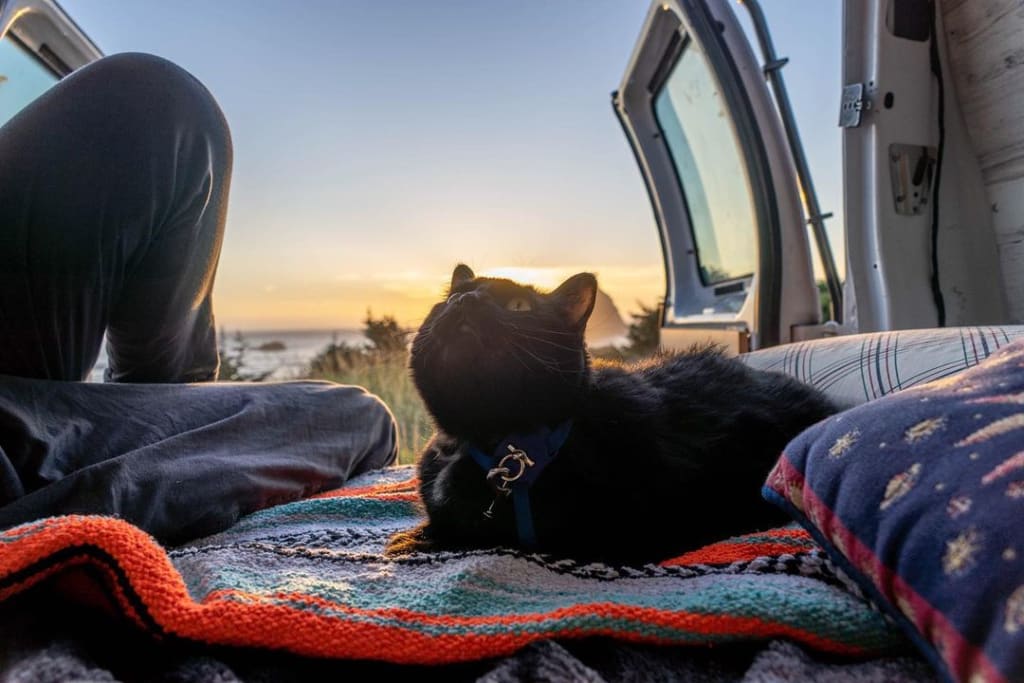Van life with a dog is a no-brainer, but cats can get in on the fun of a nomadic lifestyle too. Like canines, felines are curious creatures who love to explore new surroundings. Traveling in a van can open cats up to healthier, more vibrant lifestyles than they’d experience staying in an apartment or house.
Kitties are ideal van life companions because they are small enough to comfortably share the limited square footage of a camper van with their humans. For solo travelers, a four-legged friend can help stave off loneliness. Plus, what pet owner wouldn’t want to share the adventure of a lifetime with their pal?
If you’re a cat owner looking to transition to full- or part-time van life, you’re in the right place. We’re sharing everything you’ll need to consider for a successful van life experience with a cat. Our tips are divided into five categories: safety, comfort, training, van setup, and lifestyle.

Photo By @Travel.Voegel
Safety
It’s not fun to think about the things that can go wrong, but safety should be your number one priority when responsible for another living thing. With that in mind, we’ll get the unpleasant but necessary stuff out of the way first.
One of the biggest fears of pet-owning van dwellers is losing their beloved animals. Certain unfamiliar surroundings can stress out cats, so you should prepare for escape attempts in moments of panic. Microchip your fur baby, invest in a GPS tracker for their collar, and make sure your contact information is listed on their ID tag. While there is some overlap between these methods, they are distinct enough that you should consider using all three.
To prevent escape in the first place, get your cat used to a harness. From walks to roaming around the van on a long tether, your furry friend will be much safer in a harness than in a collar. Cats can squirm out of collars when stressed, while harnesses are more secure. Most cats don’t enjoy wearing harnesses at first but this can change with gradual training. We’ll share more on that later in the training section.
Since your companion will be spending plenty of time outside, protection from pests and illnesses is particularly important. Aside from the core vaccinations recommended for all cats, outdoor cats should receive monthly antiparasitic treatments. Bring your pet to the veterinarian before your trip to get caught up on any shots or medication prescriptions they will need. Specify to the vet that your four-legged friend will be traveling and outside often to ensure they get the proper protection.
The last safety consideration for pet-owning van lifers is temperature. Van owners doing DIY conversions will need to strategize about how to cool down and heat the van as needed. With a camper van from Rec Van, you need not worry. State-of-the-art heating and cooling systems, many of them powered by solar panels, will make life easy for you and your pet.

Photo By @Travel.Voegel
Comfort
Cats can enjoy exploring new surroundings more if they have a sense of stability in their living spaces. Optimize their comfort by outfitting your van with everything they’ll need. Being patient with feline friends as they get used to their new lifestyle also goes a long way.
For maximum kitty comfort, fit out your van with a scratching board, litter box, and special relaxing area. Cats love scratching posts and boards because the devices allow them to stretch, sharpen their claws, and mark their territory. Small boards can be attached to van walls or the sides of cupboards to save space. You’ll want a covered litter box to give your cat privacy as well as to keep the mess to a minimum. Cats are territorial, so a special spot that is just for them will be greatly appreciated. Choose a nook that is low to the floor so your pal feels more secure while you are driving.
To help your cat adapt to the new van and lifestyle, be patient and gentle. Try making the van feel as much as possible like the home they are used to. Keep the brands of their food, treats, and litter consistent. Let your companion get used to the stationary van a few times before driving. Then, short drives can be gradually extended to cover longer distances.
When it comes to helping your cat adjust to van life, slow and steady wins the race. As they adapt to the new lifestyle, you’ll see them willingly and gladly step outside of their comfort zone more and more often.

Photo By @Travel.Voegel
Training
A big part of getting your cat used to van life involves training. You will have a much easier time on the road if you can train your kitty to accept a harness and take walks.
Harnesses should be comfortable but snug. If you can fit exactly two fingers between the harness and their body, you’ve found the correct size. To gently train your cat, put the harness on them for a short time each day before you feed them. This helps them associate the harness with the positive experience of eating. Once your feline friend is comfortable in the harness, attach a leash to the harness and let them drag the leash around inside for a while. Only after they are used to the whole apparatus should you two venture outside.
Cats often enjoy exploring the outdoors, feeling the fresh air on their faces, climbing, hunting bugs, and even digging. Like dogs, they have strong senses of smell. Unlike dogs, they don’t generally like to interact with unknown pets while on walks. Other stimuli like loud cars can also scare them. When first training your cat to take walks, stick to controlled areas without potential stressors. Reward them on the walk and when you return home with treats. You can build up to longer and more daring promenades as your adventure partner gets comfortable with the activity.
Once cats are harness trained, you can also use a longer tether attached to the van. You get to keep your van doors open at a beautiful campsite; your pet gets to chill inside or play outdoors freely without wandering too far. If you trust that your cat will stay nearby, you can let them hang out at campsites without a leash or tether. However, this is inherently riskier and the decision should be made on a case-by-case basis by each pet owner.

Photo By @LoneWolf.Casita
Van Setup
When planning the arrangements of your van, expect to give up some space for your little fluffball. Besides the areas we’ve already talked about in the comfort section, you’ll need a dedicated area for your kitty to eat and drink. Consider transferring dry food to airtight plastic containers for easier storage and pest deterrence. Stow or cover food and water bowls when you are driving to prevent a mess–most cats would rather wait for a break than eat or drink while in motion anyway.
To live in true harmony with your pal, you’ll want to keep the space clean. Cats can shed a lot. One preventative solution is to regularly pet your cat with a hair remover glove. If cat hair settles on non-upholstered surfaces like counters, a damp microfiber cleaning cloth does wonders. Upholstered surfaces can be cleaned with a handheld vacuum cleaner and a lint roller or a bit of duct tape. To prevent undesirable smells, you should also expect to clean out the litter box often.

Photo By @TravelsWith.Ty
Lifestyle
Even timid indoor felines can transform into curious and bold outdoor adventurers. The key is to support them through the transition and make sure their needs are always met. If cats feel a sense of security in the van, they will be more interested in venturing out and exploring new places.
Exercise is crucial to keeping cats happy, healthy, and behaving well. Outside the van, exercise can include walks on a leash and exploring on a tether. Don’t expect cats to behave like dogs do on walks. Instead, let them be the masters of their own journeys, even if that means zig-zagging around, jumping into small trees, and taking dust baths. If you want to take your cats along on longer hikes and outdoor adventures, carry them in a travel backpack.
Fur babies can also get exercise indoors with active play. There are plenty of interactive toys to entertain a cat while you’re busy, but spending time bonding with your pet through play will be the most fulfilling for them. Try jerking around a toy that dangles from the end of a pole. Or see if your cat enjoys a laser pointer–this option gets bonus points for taking up almost no room in the van.
A common quandary for van dwellers with cats is when to leave them in the van versus taking them along. The answer will, of course, depend on whether the places you are going are cat-friendly. If you do need to leave your buddy in the van, make sure the van is parked in a safe, comfortable place. Under no circumstances should you leave animals alone in a van in hot or cold weather, as it can be dangerous. The frequency that you bring your pet along on adventures will also depend on their personality and energy levels.
Whether you are planning a summer road trip with a feline friend or getting ready to live with your pet in a van full-time, your patience and preparation will be rewarded with the opportunity to see your pal truly thrive. Together, you’ll get to see new things, grow, and reach new levels of bonding.
Curious which van you should choose? Check out “The Best Class Be Vans for Pet Owners.”


